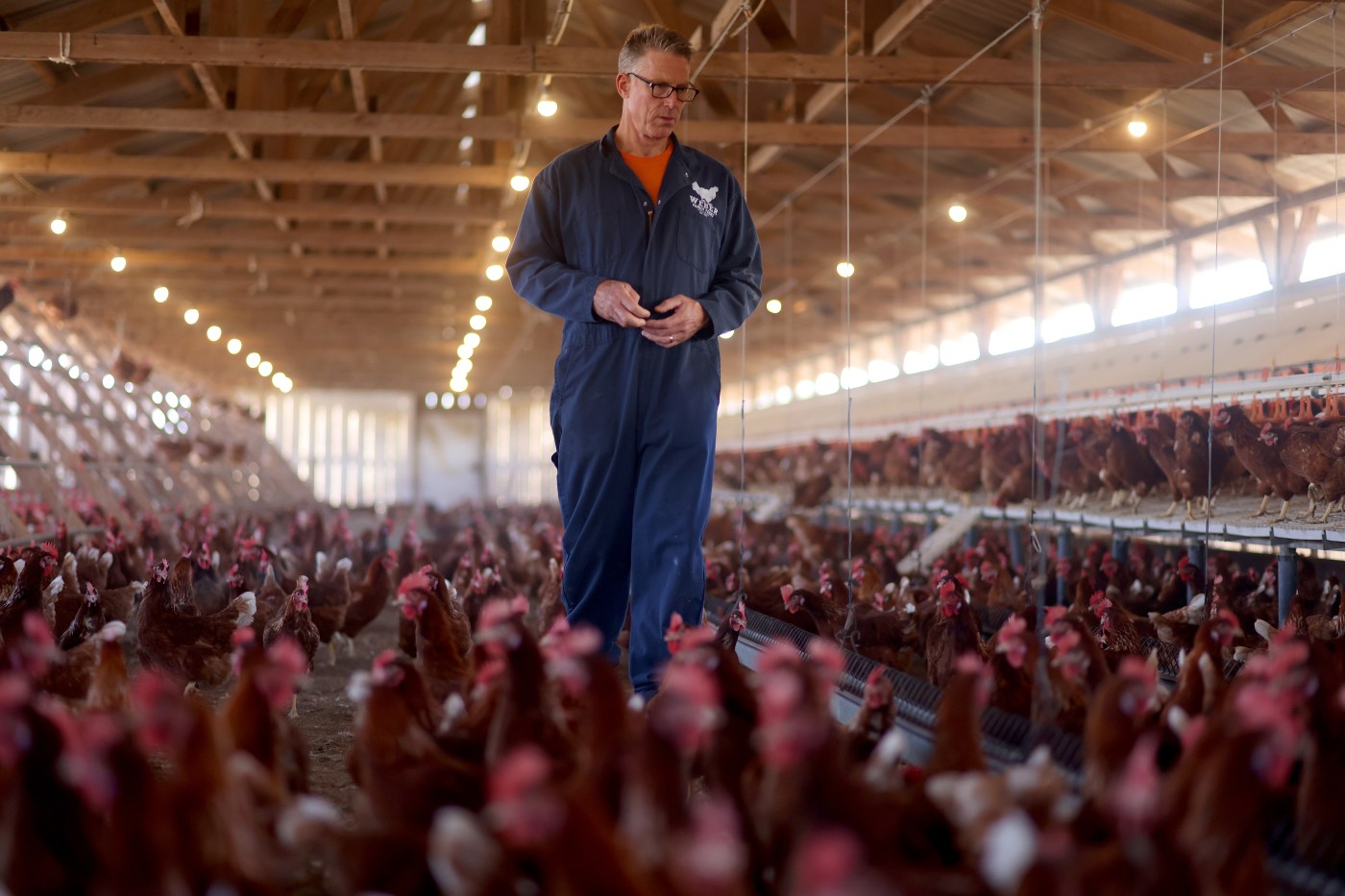PETALUMA — The chickens on Mike Weber’s farm live in coops, not cages. Their care has earned an official “Certified Humane” designation. Their organic poop, treated with solar-powered dryers, is turned into valuable fertilizer.
But there are too many of them, animal welfare activists say.
And that has put Weber, and many of his fellow Sonoma County farmers, in the political crosshairs of Measure J, a county ballot initiative that seeks to banish large poultry and dairy farms – and inspire similar efforts around the state and nation.
“It would shut us down,” said Weber, 55, a fourth-generation farmer whose family started producing eggs in 1912 and now supplies millions each week from 550,000 hens to private labels at grocery stores throughout the San Francisco Bay Area. “That’s not the way to reward somebody who has spent millions of dollars to do things the right way.”
Sponsored by a collection of local animal welfare advocates called the Coalition to End Factory Farming, Measure J has ignited a culture war, with Berkeley’s activist idealists seeking to transform the agricultural economy of rural Sonoma, famed for its world-class gastronomy.
If passed, the county ordinance could set a precedent, strengthening a slow-motion revolution that is changing the way animals are treated. While legislation stopping large farms has been introduced in Congress, this is the first measure to be put directly to voters.
It could also raise food prices and threaten the survival of farms in the former “Egg Capital of the World,” where sprawling subdivisions edge ever-closer to old red barns and rolling pastures.
“Measure J is a template and an inspiration,” said Cassie King, 26, of Petaluma, whose coalition represents 40 different animal welfare advocates. “It gives voters the power to address ‘factory farming,’ and hopefully set a precedent that can be followed in other areas.”
In recent decades, consumers have grown increasingly empathetic with animals’ living conditions, creating major reforms in welfare regulations.
California has led the way, creating some of the strongest animal “unnecessary cruelty” laws. Since California banned housing hens, pork and veal calves in cages in 2008, eight other states have passed similar rules.
The welfare effort is gaining traction as many farms are struggling to turn a profit. According to the U.S. Department of Agriculture, only 43% of the nation’s farms had positive net cash farm income in 2022. This is forcing consolidations.
Activists’ latest target is farm size. Large farms create an inhumane industrial food production system that confines docile animals to a lifetime of misery, proponents say. Such farms also poison the environment, hoard water and spread disease, they contend.
The effort to demonize large dairy and poultry farms has been led by groups like the Berkeley-based Direct Action Everywhere, which has trespassed on farms to take undercover footage and “liberate” animals. Protests are choreographed theater, with a dress code of biohazard suits, somber carnations and “funeral procession in progress” signage. Half-naked and covered in fake blood, they staged a picketing campaign outside a North Berkeley butcher shop specializing in locally sourced and sustainably raised meat.
The giant barns and endless feedlots of the Central Valley, not bucolic Sonoma, are the state’s worst culprits, agreed King, the Petaluma activist.
Cassie King, center left, talks to a student at Santa Rosa Junior College about voting yes on Measure J, Monday, Sept. 23, 2024, in Santa Rosa, Calif. (AP Photo/Godofredo A. Vásquez)
“But we have to start where we are,” she said. “Here, there is a presence. There is the desire. So let’s use that to set a precedent that can be followed elsewhere.”
An analysis by Sonoma County’s Economic Development Board identified 11 farms that confine animals and exceed the measure’s “large-scale” threshold, with more than 700 dairy cows, 85,000 egg-laying hens, or 125,000 chickens raised for meat. About 50 medium-scale operations also could be affected, it said.
Also vulnerable are farms that don’t confine animals but shelter them in the winter, such as the organic dairy Tresch Family Farms in Two Rock, whose 750 cows graze 2,500 acres and produce milk for Straus Organic Creamery, one of the Bay Area’s top milk brands.
November’s vote is the first in what analysts call a “two trip” effort, said David McCuan, a political science professor at Sonoma State University. The initial goal is to raise the profile of the issue, demonstrating whether it is viable or not, he said. If the measure, which needs a simple majority to pass, performs better than expected — losing by only 5 or 6 points — efforts will expand, he predicted.
“If you can do it here, then you take that learning experience and send it other places,” he said.
In banners and yard signs, opposition has united many Sonoma County locals who seek to protect their region’s rich agricultural heritage, only 50 miles or so north of the Golden Gate. At least $1.3 million had been raised as of late September to defeat the measure, with major gifts from Western United Dairies, Perdue’s Poultry and the National Pork Producers Council in Iowa. Supporters had raised less than $200,000.
Measure J, put forward by the Coalition to End Factory Farming, a group of animal advocacy groups, would force Sonoma County farms with 700 or more dairy cattle or at least 82,000 laying hens — to close or downsize within three years.
With no reliable polling on voter sentiment, its fate is unclear.
In a rare show of political unity, both the local Republican and Democratic parties are opposed, along with a slew of local cities and lawmakers, chefs and animal care experts.
It is opposed by Straus Family Creamery and Clover Sonoma, which buy more than half their milk from Sonoma County. Cowgirl Creamery, arguably the Bay Area’s most iconic cheese company, is opposed.
The Marin Agricultural Land Trust warned about “the ripple effect it will have on our vibrant food systems.”
Ranchers in the San Bernardino Valley, Tuolumne and elsewhere donated to the opposition.
“We believe in supporting each other…when extreme animal rights activists introduce flawed ballot measures,” said John Hammon of the Tulare County Cattlemen’s Association, 300 miles away.
Weber, the poultry farmer, and his younger brother Scott have pondered how to improve and save a farm that was started with tiny hen houses on a handful of acres by their great grandparents, economic refugees from Germany.
With an MBA from Santa Clara University and experience at Hewlett Packard and Intel, Weber spent the brothers’ inheritance on modernization, adding new, larger and cage-free buildings. They installed belts in the hen houses to carry away poop, so there is less stink and fewer flies. The poop is air-dried, processed into pellets and sold as fertilizer.
Recent years have been stressful. They’ve added locks to their facility doors after activists broke in, and screens on their henhouses to fend off wild birds carrying avian flu.
Related Articles
Farms or subdivisions? Ballot measure would curb development on Silicon Valley’s southern edges
Letters: East Bay parks | Gas prices | Dems’ no votes | Harris’ inexperience | Racism’s role
Letters: Stebbins for judge | Prop. 33 | Prop. 5 | Artificial turf | Trump and Musk | Affirmation vs. punishment
Berkeley councilmembers running for reelection in city divided over homelessness
Here are the candidates running for mayor in Sunnyvale
He keeps the results of his annual audit from the certifying organization Humane Farm Animal Care in a tidy white binder. “Good bird condition, detailed records, good litter quality,” it reads. “Clear records, efficient and detailed traceability. Knowledgeable, attentive employees.”
The only way that Weber Farms could comply with Measure J is to buy more parcels to split up the flocks, he said. But with Sonoma farmland selling for $300,000 an acre, that’s out of reach.
“This has nothing to do with how good of a job we’re doing,” he said with bitterness. “And if you get rid of your good operators, where are you going to get your food?”












